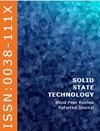Semiconductor processing with excimer lasers
Q4 Materials Science
引用次数: 2
Abstract
The advantages of pulsed excimer lasers for semiconductor processing are reviewed. Extensive comparisions of the quality of annealilng of ion‐implanted Si obtained with XeCl and ruby lasers have been made. The results indicate that irrespective of the large differences in the optical properties of Si and UV and visible wave‐lengths, the efficienccy of usage of the incident energy for annealing is comparable for the two lasers. However, because of the excellent optical beam quality, the XeCl lasser can provide superior control of the surface melting and the resulting junction depth. Furthermore, the concentrations of electrically active point defects in the XeCl laser annealed region are 2−3 orders of magnitude lower than that obtained from ruby or Nd:YAG lasers. All these results seem to suggest that XeCl lasers should be suitable for fabricating not only solar cells but also the more advanced device structures required for VLSI or VHSIC applications.准分子激光器的半导体加工
综述了脉冲准分子激光器用于半导体加工的优点。用XeCl和红宝石激光器对离子注入硅的退火质量进行了广泛的比较。结果表明,尽管硅、紫外和可见波长的光学性质存在很大差异,但两种激光器的入射能量利用效率是相当的。然而,由于出色的光束质量,XeCl激光器可以提供更好的控制表面熔化和由此产生的结深度。此外,XeCl激光退火区的电活性点缺陷浓度比红宝石或Nd:YAG激光器低2 ~ 3个数量级。所有这些结果似乎表明,XeCl激光器不仅适用于制造太阳能电池,还适用于制造VLSI或VHSIC应用所需的更先进的器件结构。
本文章由计算机程序翻译,如有差异,请以英文原文为准。
求助全文
约1分钟内获得全文
求助全文
来源期刊

Solid State Technology
工程技术-工程:电子与电气
CiteScore
0.30
自引率
0.00%
发文量
0
审稿时长
>12 weeks
期刊介绍:
Information not localized
 求助内容:
求助内容: 应助结果提醒方式:
应助结果提醒方式:


